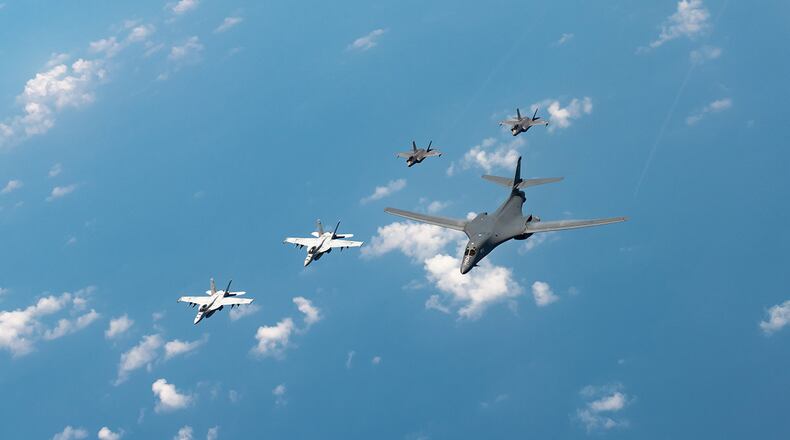“Our unique strength as an Air Force is our ability to generate integrated actions with our joint teammates and allies and partners to challenge competitors in a time and place of our choosing,” said Gen. Ken Wilsbach, PACAF commander. “These simultaneous airpower missions demonstrated our capacity and readiness to deliver a wide range of proactive, scalable options to quickly deploy our forces to support our mission of ensuring a free and open Indo-Pacific theater.”
The first display of airpower came when two B-1s from Ellsworth Air Force Base, South Dakota, took off from Ellsworth AFB and flew to the East Sea. Once there, they integrated with the Koku Jieitai, or Japan Air Self-Defense Force, and further strengthened relationships by training together.
“The Koku-Jieitai has participated in bilateral trainings on a continuous basis, and I have no doubt that our efforts result in strengthening the alliance and partnership between Japan and the U.S.,” said JASDF Lt. Gen. Shunji Izutsu, commander of the Air Defense Command. “Training in a complex situation like this large force employment improves not only tactical skills, but also interoperability and mutual trust.”
While the two “Bones” were en route to the East Sea, another set of two B-1s took off from Andersen Air Force Base, Guam.
In addition to the two sets of bomber missions, four F-15C Eagles from Kadena Air Base, Japan, also made their way to the East Sea to integrate with the four B-1s, the U.S. Navy’s USS Ronald Reagan Carrier Strike Group, F-35 Lightning IIs assigned to Marine Corps Air Station Iwakuni, Japan, and F-15J aircraft from the JASDF to conduct large force exercise training.
“High end, integrated training with our Air Force peers enhances our capability to respond to any contingency, and meet any challenge,” said U.S. Navy Rear Adm. George Wikoff, Ronald Reagan Carrier Strike Group commander. “U.S. joint integration demonstrates our unwavering commitment to regional defense agreements with our allies and partners.”
Upon completion of integration and training, the fighters returned to Kadena AB while the four B-1s returned to their home station in South Dakota.
Credit: 18th Wing Public Affairs
Credit: 18th Wing Public Affairs
Finally, while integration and training were happening in the East Sea, two B-2 Spirit bombers from Whiteman Air Force Base, Missouri currently deployed to Naval Support Facility Diego Garcia delivered their own unique capabilities in the theater.
In the Indian Ocean, the B-2s conducted joint interoperability tactics training before returning to Diego Garcia.
These missions show the ability of Air Force Global Strike Command to deliver lethal, ready, long-range strike options to geographic combatant commanders anytime, anywhere.
“I’m proud of how we as a military and our allies and partners worked together to demonstrate our resolve for a free and open Indo-Pacific,” Wilsbach said.
About the Author

